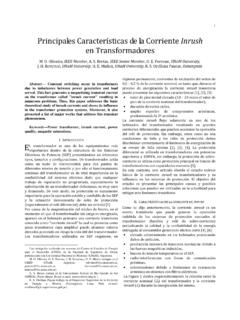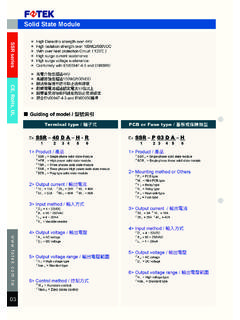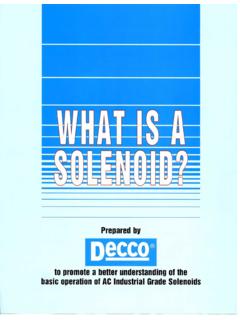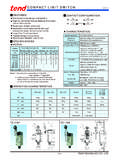Transcription of Inrush-current limiter circuits (ICL) with Triacs and ...
1 AN4606. Application note Inrush-current limiter circuits (ICL) with Triacs and Thyristors (SCR). and controlled bridge design tips Introduction At application start-up, a high current can be sunk from the mains due to transient energy demand to start the system. Such inrush current could come from motor start-up, DC. capacitor charge or the low value of resistor impedance at cold temperature. A high inrush current can cause several issues for the system like component failure (fuse, bridge diode, etc.) but also represents an excessive current stress on the power grid compared to the nominal current sensed in steady state. Indeed, if nothing is implemented to limit the inrush current, the start-up current can easily be 10 to 20 times higher than the steady-state current. The power grid wires and other current protection components have then to be rated to deliver such high current for a short time.
2 Moreover, the sudden current variation will lead to Line voltage dips. These fluctuations will decrease the power delivered to other loads. Then lamps or displays connected on the line could show brightness variation called the flicker phenomenon. To avoid such unwanted phenomenon, the IEC. 61000-3-3 Electromagnetic standard defines the maximum voltage fluctuation which can be accepted, and so the maximum repetitive current, according to the application case. Today, one of the major sources of high inrush current comes from the DC capacitors which are charged by a diode bridge. This document lists the different topologies which can be implemented with SCR (silicon-controlled rectifier) or Triacs to implement an Inrush-current limitation (ICL) circuit. Tips are given to design such circuits , with a particular focus on the controlled bridge solution.
3 This document is split into different sections which deal each a specific topic and which can be read separately (references are given to other sections if the reader requires further explanation). March 2016 DocID027054 Rev 2 1/26. 26. Contents AN4606. Contents 1 ICL circuit topologies .. 3. Bypass solutions .. 3. Soft-start solutions .. 4. 2 Control circuits .. 7. Auxiliary winding solutions .. 7. Opto-coupler .. 7. Typical schematic .. 7. Gate resistor selection .. 8. LED current setting .. 10. Pulse transformer .. 10. 3 Mixed-bridge design tips .. 13. Impact of gate current on leakage current .. 13. On-state power losses .. 15. Protection towards voltage surges .. 16. IEC61000-4-5 differential-mode positive surge applied at peak mains voltage .. 17. IEC61000-4-5 differential-mode negative surge applied at peak mains voltage.
4 19. IEC61000-4-5 differential-mode positive surge applied at zero mains voltage .. 22. Determination of the surge current .. 23. 4 Conclusion .. 24. 5 References .. 24. 6 Revision history .. 25. 2/26 DocID027054 Rev 2. AN4606 ICL circuit topologies 1 ICL circuit topologies Bypass solutions Bypass solutions are the solutions traditionally used for Inrush-current limiter ( ICL ) circuits . The capacitor Inrush-current is limited by a resistor (refer to RLIM in Figure 1 to Figure 4). which can be either a fixed-value resistor or a temperature-variable resistor. Temperature- variable resistors present usually a negative thermal coefficient (NTC) so that the resistor will have a high impedance value in cold-state, at start-up, and a low impedance value at steady-state. The low-value resistor is required at steady-state to limit the power losses dissipated by this resistor which becomes redundant as soon as the start-up is finished.
5 But to reduce the NTC resistor losses, a better solution is then to turn on a switch in parallel to bypass its impedance. Designers were used to use a mechanical relay for the bypass switch (cf. S1 on Figure 4). But such technologies have several drawbacks, for example: High current consumption for the coil Risk of relay opening in case of machine vibrations Acoustic noise due to the mechanical contact Risk of explosion in flammable environment (due to switching spark). Poor reliability (especially if the relay is switched on or off when a high DC voltage or a high current is present). Bulky solution Below figures give the three different solutions which can be used: Figure 1: Bypass device is put on DC side and is implemented with a single SCR. Figure 2: Bypass device is put on AC side and is implemented with a single Triac Figure 3: Bypass device is put inside the bridge and is implemented with two SCRs in a mixed bridge.
6 Figure 1. Bypass device is put on DC side Figure 2. Bypass device is put on AC side / 7 $X[LOOLDU\. VHFRQGDU\ . $X[LOLDU\ ZLQGLQJ . VHFRQGDU\ . ZLQGLQJ /. 7. 9$&. 9$& 5/,0. 5/,0 3 RZHU )DFWRU . &RUUHFWRU 7 3 RZHU )DFWRU . & &RUUHFWRU . & LI 7 & DQG & . QRW DGGHG & &. DocID027054 Rev 2 3/26. 26. ICL circuit topologies AN4606. Figure 3. Bypass device is put inside the bridge Figure 4. Mechanical solution for ICL resistor bypass and stand-by losses removal 5/,0 ' 6 . ' ' 6 . / 7 7 ' . 9$&. 9$& . 5/,0. & &. ' ' . 3)&. The schematic in Figure 2 is the only one able to operate with an AC voltage doubler circuit (implemented with Triac T2, which could be an AVS08 or AVS12 device; and capacitors C1. and C2). The current which charges both C1 and C2 is actually always passing through RLIM or Triac T1. In case a voltage doubler (with T2, C1 and C2) is implemented in Figure 1.]]
7 And Figure 3 schematics, RLIM resistor can only limit the current charging C1 capacitor. So the Inrush-current could be limited if the application is plugged into the mains during a negative voltage half-cycle. Please also note that a voltage doubler is useful only if no PFC circuit is used. Indeed a PFC. is able to regulate the DC bus to a constant level even if the AC line voltage varies between 90 to 270 V. The schematic in Figure 3 could eventually be able to operate with an AC voltage doubler circuit but the two SCRS (T1 and T2) should be placed on the same bridge leg (with for example, T2 cathode connected on T1 anode) instead of a common-cathodes circuit. This means that both SCRs could then not be supplied from the same voltage supply. Mixed bridge solutions avoid a device to be added in series with the diode bridge.
8 Such a solution is then preferred versus the single-SCR or Triac solutions for applications where a high power efficiency is required. Soft-start solutions The drawback of the solutions presented in Figure 1 to Figure 4, is that the RLIM resistor is always connected to the line (through the diode bridge) even if the application is in stand-by mode. To reduce the losses which can be dissipated by the application, for example due to the high voltage which is still applied on the DC side through RLIM, a switch has to be used in series with the line voltage (as shown in Figure 4 where S2 is open to disconnect the diode bridge in stand-by mode and thus remove the stand-by losses). Such a solution for sure increases the total solution cost. Another smarter solution involves simply removing RLIM resistor. Figure 1 to Figure 3.
9 Schematics could actually work if RLIM resistor is replaced by an open circuit. The whole solution for ICL function and stand-by losses suppression is then implemented by one or two SCRs, or a single Triac, instead of one ICL resistor and two mechanical relays as shown on Figure 4. For the schematic of Figure 3, D3 and D4 diodes can also be removed. The solid-state technology could then be cheaper than the mechanical technology solution 4/26 DocID027054 Rev 2. AN4606 ICL circuit topologies and will bring also the advantages already listed in Section : Bypass solutions (increased reliability, acoustic noise suppression, etc.). RLIM removal solution with SCR and Triac ICL function can work if the three following conditions are satisfied: 1. An inductor is present in series with the Line (refer to L in previous schematics).
10 2. The control circuit is able to implement a progressive soft-start of the device previously used as a bypass switch. 3. An auxiliary supply is present to supply the MCU before the DC output capacitor is charged (refer to C in above schematics) so that the MCU can ensure the inrush - current limiter soft-start. It should be noted that condition 3 should be fulfilled in most circuits where the consumption in stand-by mode is a concern. Indeed, the stand-by mode means that the most part of the circuit is unpowered but some basic functions have still to be ensured (like MCU reactivation in case a RF or IR signal is received). These applications use a low-power auxiliary supply to provide the MCU with enough energy during the stand-by mode. A bigger power supply is then activated during normal operation mode. It should also be noted that condition 1 should be fulfilled almost for free as most applications using a DC bridge feature an SMPS or a motor inverter.
















